King Crab Norway – All about the Red King Crab, Recipe & How to Catch
Anyone traveling in the northernmost regions of Norway – whether for diving, fishing, or Spearfishing – may have already heard of it: the Red King Crab (Paralithodes camtschaticus). With a span of almost two meters and a weight of up to ten kilograms, it is a true giant of the Arctic. Its appearance is almost intimidating: a spiky dark-red shell, enormous claws, and long legs that crawl across the seabed like spider arms. Once alien to these waters, it is now a permanent part of Norway’s coastal world – and sparks plenty of debate among researchers, fishermen, and ocean lovers.
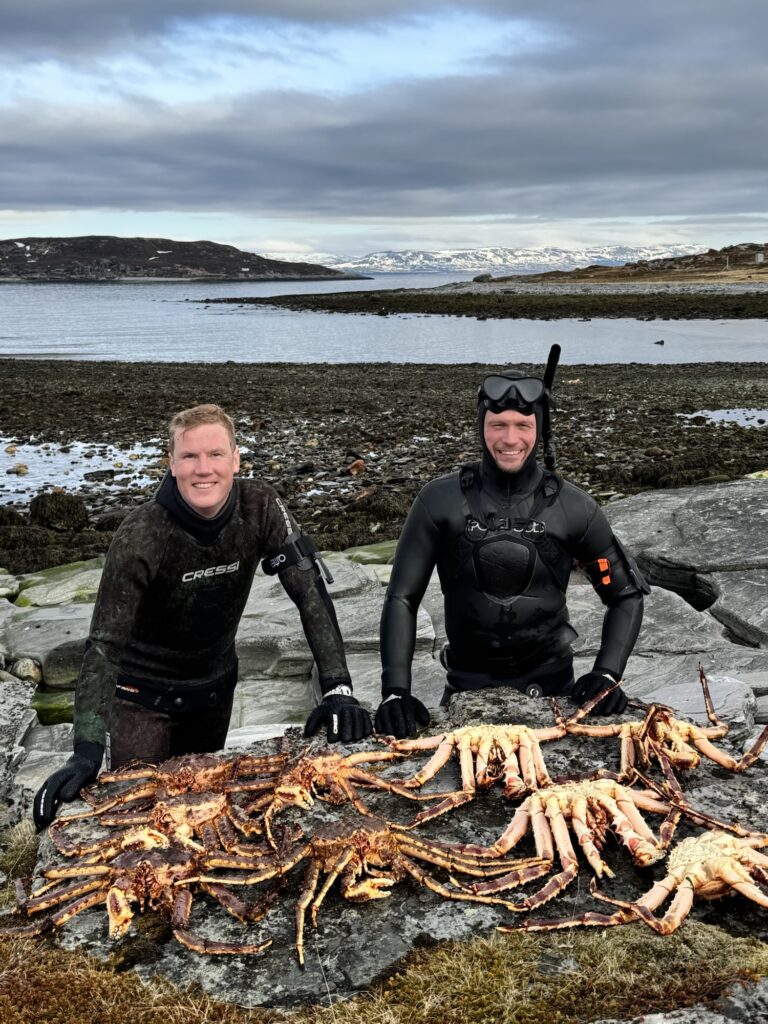
Inhaltsverzeichnis
- 1 Origin of the King Crab: From Kamchatka to Norway
- 2 Why is it called “King Crab”? – Two Stories
- 3 Biology and Lifestyle of the King Crab
- 4 King Crab in Norway: Ecological Problem or Delicacy?
- 5 Recipe: Cooking King Crab – Steaming Instead of Boiling
- 6 Conclusion: King Crab in Norway – Curse, Blessing, and Fascination
Origin of the King Crab: From Kamchatka to Norway
The King Crab originally comes from the North Pacific, specifically the Bering Sea and the Sea of Okhotsk. For centuries, it has been a highly sought-after catch. In the 1960s, Soviet scientists decided to introduce the species into the Barents Sea to establish a new fishery resource. Around 1,000 specimens were released near Murmansk – a biological experiment with far-reaching consequences.
Since the 1990s, the King Crab has migrated massively westward into Norwegian waters. Today, it is omnipresent in the Varangerfjord, and its catch boundary shifts further along the coast every year.
Why is it called “King Crab”? – Two Stories
There are two common explanations for the name:
The giant among crustaceans – With its enormous size and striking red color, the crab is considered the ruler of the seabed. Its majestic appearance, armored and with powerful claws, resembles an armored king. The Norwegian tale of blood – In Northern Norway, another explanation is passed down: the blood of the King Crab is usually clear like water. But when it hits snow, it turns blue. For local fishermen, this was an almost mystical phenomenon – and they said that only a “king” could carry such “royal blue blood.”
Biology and Lifestyle of the King Crab
The King Crab is an omnivore. It feeds on mussels, starfish, snails, worms, small crabs, and even carrion. Thanks to its strong shell, it has few natural enemies. Young crabs may occasionally fall prey to cod or halibut, but adults are almost untouchable.
A female can carry up to 300,000 eggs. After hatching, the larvae drift freely in the water for months before settling on the seabed. Some individuals live for more than 20 years.
King Crab in Norway: Ecological Problem or Delicacy?
As fascinating as the sight of a King Crab is for divers – from a marine biology perspective, it is a problem. In large numbers, they can devastate the seabed. Entire mussel beds disappear, worms and other soft-bodied animals are heavily reduced. Studies show that biodiversity in areas with high crab density decreases significantly.
On the other hand, the King Crab is an economic powerhouse. Its meat is considered a delicacy – sweet, tender, and firm at the same time. On Asian and U.S. markets, customers pay premium prices.
How do I kill a King Crab?
The King Crab can be killed quickly and easily with a knife thrust into the head area. The shell is surprisingly soft! Important: only a very short time (30 minutes, max. 1 hour) should pass between killing and cooking. The reason? Enzymes in the crab cause the meat of the King Crab to become soft and mushy very quickly. Therefore: cook quickly and enjoy immediately! In the video you can see how a King Crab is killed:
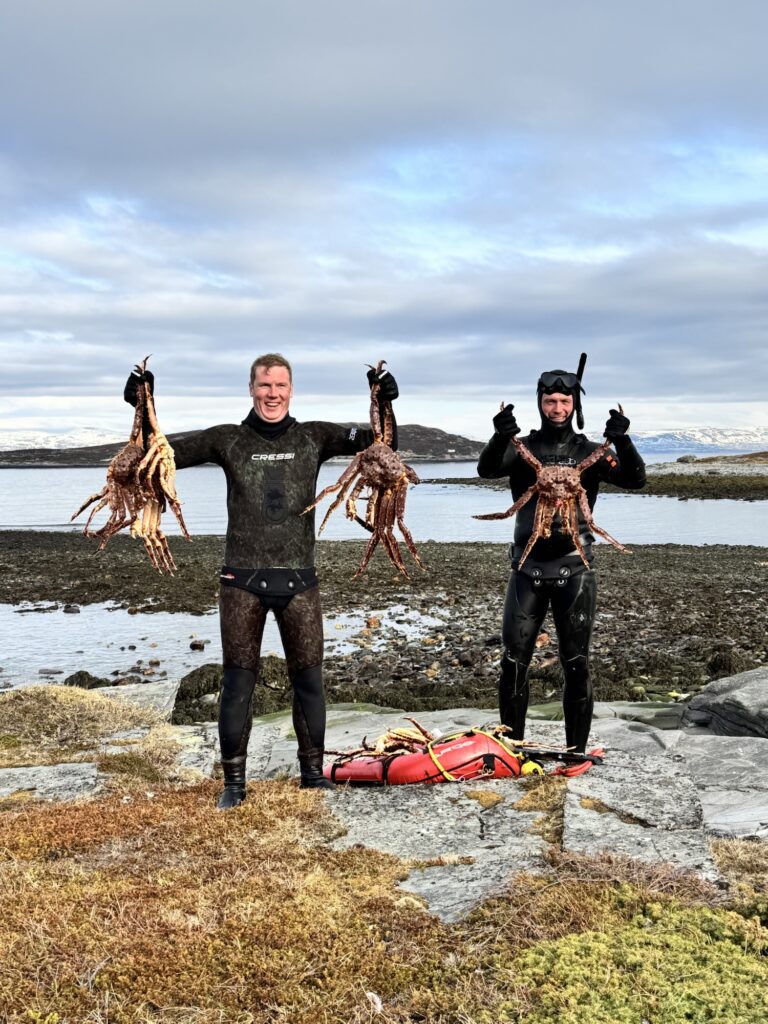
What parts of the King Crab can you eat?
Before cooking, remove the legs and pairs of claws of the King Crab. With a knife, cut out the three large legs on each side. The joints of the legs contain a lot of meat! The head itself contains little edible material and is discarded.
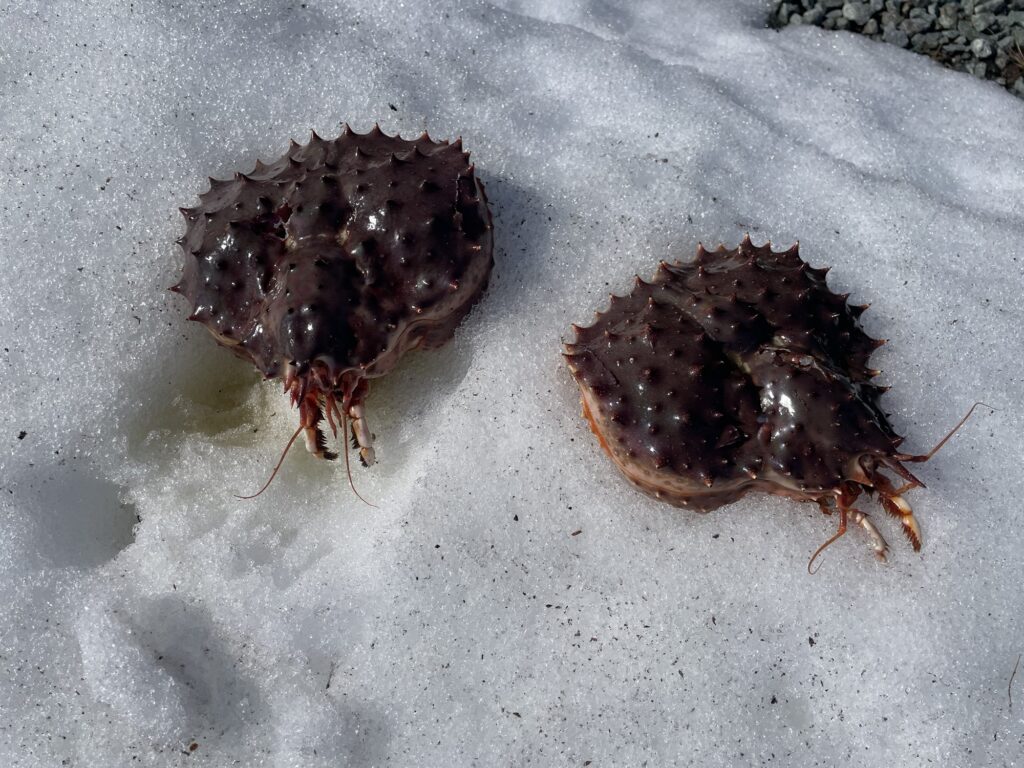
Recipe: Cooking King Crab – Steaming Instead of Boiling
The meat of the King Crab is so flavorful that it requires almost no seasoning. The key is the right preparation – not boiling, but steaming.
Here’s how to do it perfectly:
Take a large pot and pour some salted water at the bottom. Place a suitable sieve or steamer insert above it. Place the crab legs inside and close the lid. Steam for 5–8 minutes until the legs turn bright red. Remove, crack open, and serve immediately – either plain or with melted butter and lemon.
Extra tip: If cooking outdoors by the fjord, you can also cut the legs lengthwise, brush with garlic butter, and grill directly over an open fire.
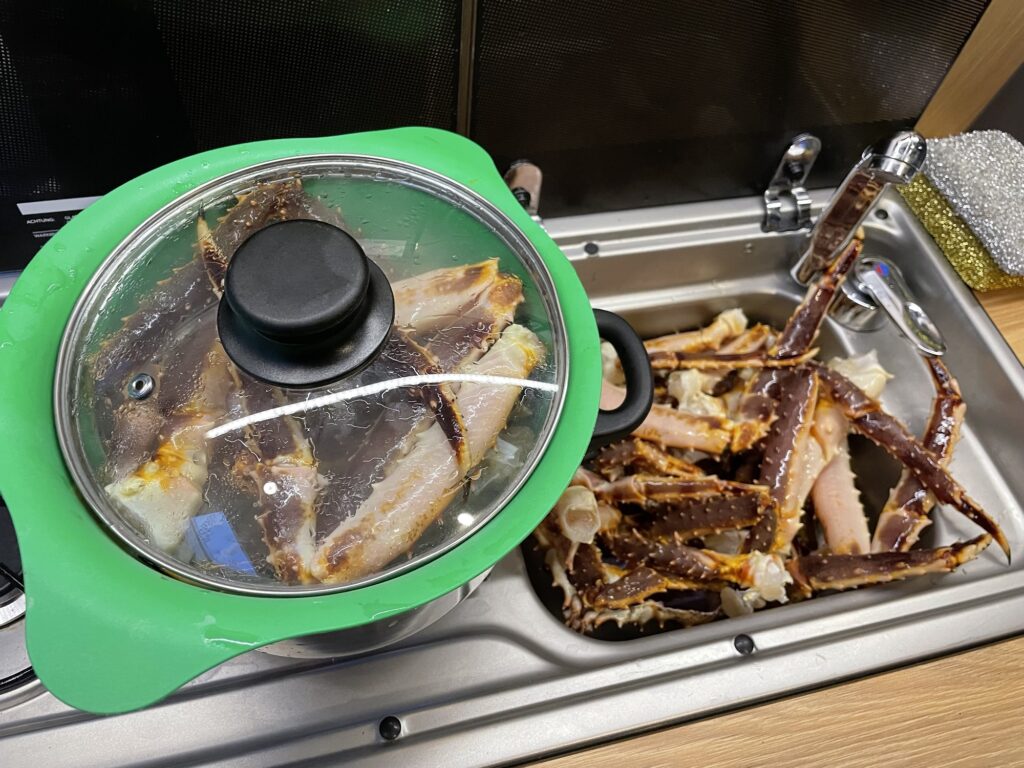
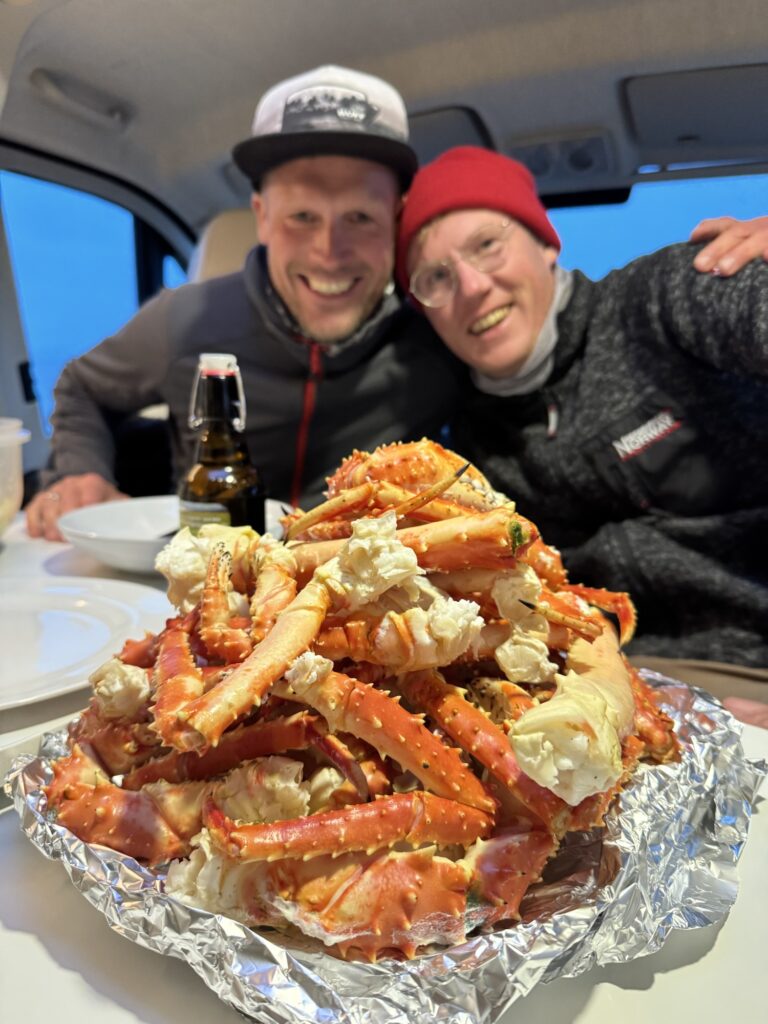
Freezing King Crab – How to Do It Right!
Before freezing King Crab, the legs should be thoroughly cleaned – no seaweed or algae should remain on them, best done with a scrubbing brush. Then steam the legs for 5 minutes as described above. Let them cool completely! In May, the abundant snow works perfectly for this. Simply place the legs on the snow. Once cooled, wrap them in paper towels and place them in bags. Vacuum sealing extends shelf life, but be careful: the countless spines easily puncture the vacuum! Then straight into the freezer and cool as aggressively as possible. This way, the legs last at least half a year! To defrost, place the legs in the refrigerator for 1–2 days. Thawed legs are not quite the same as fresh ones – the meat may look slightly collapsed. Still excellent for cooking or lobster rolls!
Blue deposits in King Crab legs?
After cooking, you will often find bluish deposits on the meat inside the legs. Don’t worry – these are simply pigments from the crab. They may look a little unappealing, but they are harmless and easy to remove.
Conclusion: King Crab in Norway – Curse, Blessing, and Fascination
The King Crab in Norway is a prime example of nature’s contradictions. It is invasive and changes ecosystems, but at the same time provides one of the most exquisite seafood experiences in the world.
Whether you see it as a problem, a delicacy, or an adventure in the fjord – it fascinates everyone who encounters it. And anyone who has once pulled a King Crab out of the water with their own hands and later enjoyed it on the plate understands why it so rightly bears this majestic name.

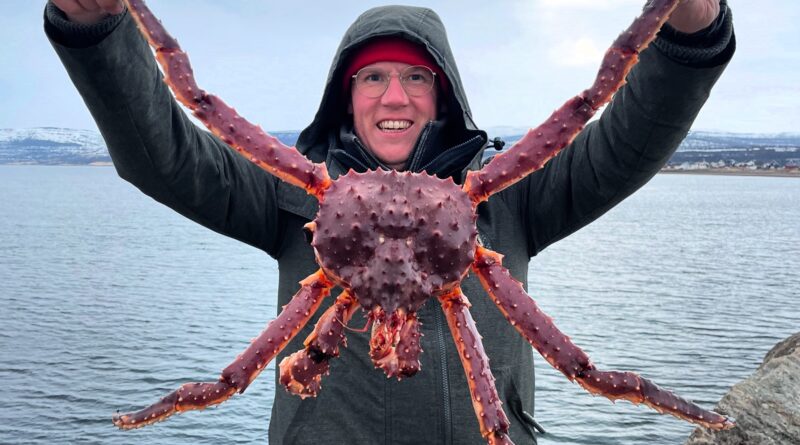


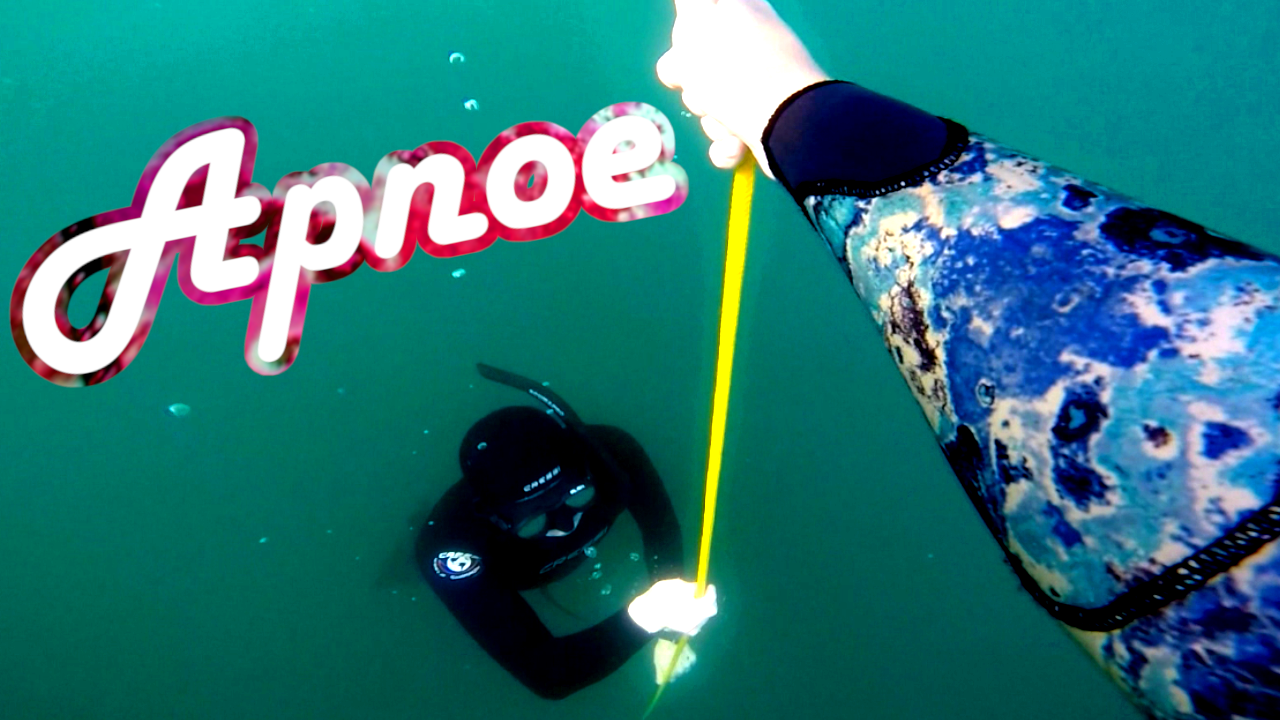

Comments are closed.